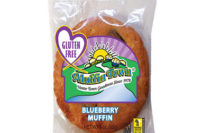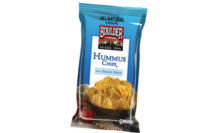“Many of today’s ingredients are much more concentrated, so if a baker is off, even a gram or two, it will be the difference between creating a good dough and one that has issues,” says Ken Skrzypiec, Eastern vice president of sales and director of technical services at Brolite Products Inc., Streamwood, Ill. “This is especially true as more enzymes are used. We’re talking about parts per million, and that’s critical on the scaling.”
Premixes also can increase efficiency in terms of ingredient procurement, inventory management and lot control, since they decrease the amount of materials bakers and snack producers must store and handle.
Although convenience usually comes at a price, depending on the complexity of the operation and formula, premixes can result in cost savings for bakers and snack manufacturers. They can reduce labor and enable food producers to leverage the premix manufacturer’s supply chain. They also can help bakers and snack manufacturers realize large gains by enabling them to optimize costly ingredients by using them in low doses in combination with other ingredients.
However, while bakers and snack manufacturers want to save money and sell their products, they don’t want to sacrifice quality. “The current economic conditions have put us all in a mindset to try and do more with less,” says Jesse Weilert, manager of bakery applications at Caravan Ingredients, a Lenexa, Kan.-based provider of functional food ingredients, nutritional premixes and baking supplies. “This has made an impact on how premixes and bases are formulated. Everything from new technology deployment to optimized premix usage levels are being used to provide as much value as possible.”
In today’s baking environment, obtaining quality is becoming more challenging as emphasis on enzyme-based technology increases and reliance on traditional chemical systems decreases.
“Utilizing an enzyme that shows a functional difference when the dose is changed by two or three parts per million makes consistency and accurate doses very important,” Weilert says. “This becomes more achievable by utilizing premixes. It’s also important to remember that with a premix comes technical backing by the supplier. It’s like having an extension of the company’s research-and-development and technical service community. This is something that might not be available if individual raw materials are being purchased on the open market.”
In addition to enhancing product quality, premixes can enable bakers and snack manufacturers create products that meet consumer dietary needs and trends by adding or omitting certain ingredients.
“On the addition side, more whole grains, specialty grains, ancient grains, fiber and improved shelf-life all have been a focus,” Weilert explains. “On the removal side are issues such as cleaning up labels and reducing and/or eliminating ingredients like trans-fat, genetically modified organisms (GMOs), chemical oxidation and conditioners, sugar, gluten and sodium.”
Skrzypiec notes that “trans-fat-free is still a push with complete bread mixes and bases, and creating a clean label is big. Also, people are looking to reduce calories without sacrificing the flavor, texture or quality of baked products. Sometimes, this is easier to do than at other times. It depends on the requirements of the bakery customers.”
Depending on the ingredients and product requirements, some of these areas can result in production challenges for bakers and snack manufacturers. “Gluten-free, for example, requires isolation of the premix manufacturing and specialized testing to ensure no cross contamination has taken place,” Weilert explains.
Mixing it up
Grain Millers Inc. in Eugene, Ore., offers premixes that do and don’t require gentle handling. “The first category includes flakes that can break down during blending,” says Rajen Mehta, senior director, specialty ingredients. “These flakes and other grain components are used in everything from toppings for bakery products to oatmeal, where one wants the flakes to be intact. The second category includes powder blends and cut grains.”
Grain Millers recently introduced mixes for tortillas, flatbreads and other products using grain blends ranging from the commonplace to the more unusual. Many of these premixes are proprietary.
“One highly-successful mix this year for a major company consisted of gluten, oat fiber, nontraditional flour-based sweeteners and six whole-grain flours, including ancient grains,” Mehta says. “The manufacturer just adds water, oil, yeast and wheat flour, and then makes the bakery product using traditional [production] lines.”
Grain Millers is actively developing new blends in the areas of flourless bakery mixes, gluten-free mixes and fiber mixes in response to customer requests. Bran-germ blends also have become more popular. “We are going to build on our ancient grain sourcing capabilities and also on our in-house technical and process capabilities related to leveraging enzyme treatment to improve functionality and deliver on needs such as low sugar and low sodium,” Mehta explains.
Brolite Products also offers premixes with customer-driven bases and concentrates. These range from simple dough conditioners to bread mixes and bases to cake mixes and bases. “This is where we see a lot of our growth,” says Skrzypiec. “A customer will tell us they’re looking to stay within certain parameters or plan on doing something specific with the product. This will require an enhancement that strengthens it or provides for a cleaner label.” The new mixes are not proprietary, so they can be used by other bakeries.
While Bay State Milling, Co., Quincy, Mass., develops bakery premixes for a variety of products and customers, the pizza category is a major area of focus for the company. Its most recent launch is a mix called Easy GrAin Pizza Crust Mix. It was developed to meet the needs of pizza producers serving the National School Lunch Program, a federally assisted meal program in public and nonprofit private schools and residential childcare institutions.
“The regulations regarding whole-grain content, protein, sodium and fat are very confusing,” says Colleen Zammer, director of product marketing for Bay State Milling. “Our goal was to simplify this.”
Easy GrAin is formulated with 51% whole-grain flour, which produces a chewy, crispy, golden pizza crust. A majority of Bay State Milling’s pizza premixes contain all of the traditional crust ingredients, including flour, sugar, salt, oil, and, depending on the customer, yeast. Water is the only ingredient that needs to be measured and added.
“Our customers are primarily seeking operational simplicity and improved nutritional content in a premix that also delivers on great taste,” Zammer notes. “This is the same, whether the premix is going into a flour-based product or a gluten-free product.”
Premix maker challenges
Like bakers and snack producers, premix manufacturers are facing new challenges due to consumer eating trends and changing their formulations to address demand for products made with whole grains, ancient grains, less sodium and sugar and no gluten.
“This is why we have developed some of our new items and have delivered on enzymatically-treated flours that allow for the reduction of added sugars and enzymatically-treated dough conditioners,” Mehta says. “Our forte is in natural and viscous fibers that haven’t seen any chemical treatment, and thus, have the benefits of natural grains.”
Using premixes not only can help increase line efficiencies, but also reduce downtime caused by matching blending to line speeds and waiting for blending to be completed. By incorporating premixes, bakers and snack manufacturers have the ability to blend more ingredients to meet a product’s health goals.
Bay State Milling, on the other hand, hasn’t found the need to change its formulations of existing premixes for customers. “We have certainly seen our fair share of new developments to meet changing needs,” says Zammer. “Not all consumers move at the same pace of change, especially when it comes to eating habits. Many manufacturers prefer to offer a new product in addition to their current line to provide consumers with choices and perhaps to wait and see if a culinary trend is truly a trend or just a passing fad.”
Brolite, meanwhile, is looking at simplifying the process and making a consistent, stable product for bakers.
Not surprisingly, it can take an R&D team a long time to create a sought-after mix. “One of the challenges is that customer expectations in this area are very high, and people are more sophisticated in what they’re looking for,” Skrzypiec says.
The impact of rising
ingredient costs
There have been significant cost implications for many commodities and specialty ingredients over the last several years. Almost all commodities are increasing in price, with ingredient costs doubling over the past seven to 10 years, depending on the item.
Enzyme and emulsifier costs have gone up substantially, as have grain prices. And while some commodities, such as flour, have stabilized in price, specialty flours and rye, along with some grain blends, have become more expensive.
Factors such as last year’s drought, oil prices, the cost of guar gum and the economy in general all have impacted the cost of certain ingredients.
“When we look at the guar market, for example, it has been a rollercoaster ride of uncertain pricing and supply issues,” Weilert says. “As a supplier of blends that contain components like guar, we do what we can to formulate with alternative technology that is showing more price stability without impacting functionality.”
In the case of guar, Caravan Ingredients conducted a product-by-product evaluation to determine if functionally the company could offer customers other options based on their specific application. Ingredients like emulsifiers and enzymes were paired with guar and other gum systems to reduce the overall need for guar, without lowering finished product quality.
Grain Millers partners with customers to better forecast the ingredients they are likely to need and price implications. This gives the company the flexibility to change formulas to take advantage of lower pricing on alternative ingredients that will still work in customers’ mixes.
“The cost of ingredients has impacted premixes,” Skrzypiec says. “We’re not spared these increases when raw ingredient prices go up. But because we’re ordering in larger quantities for a larger base of customers, we have buying power, so our prices won’t go up nearly as much as [those for] wholesale bakers.”
The bottom line is that, when it comes to premixes, bakers and snack manufacturers want products that offer consistency, accuracy, integrity in line with their goals and on-time delivery, as well as enable them to quickly react to changes in demand. “They also require competitive pricing and the ability to partner with a supplier that is willing to invest in capital and work with sourcing strategies from farm to retail pack and everything in between,” Mehta says.
Today’s premix manufacturers are ready to meet their customers’ needs and wants, and savvy bakers and snack manufacturers are ready to reap the rewards stemming from better inventory control, fewer production errors and ingredient-cost control. SF&WB






